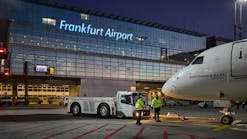Milwaukee — At the 17th annual Environmental Management Conference hosted by the American Association of Airport Executives here in June, all the usual issues came up — air and water quality, recycling and waste management, deicing, and reducing carbon footprints. Still, as they have been of late, greenhouse gas emissions, carbon footprints, and alternative fuels were the stars of the show.
Kicking off the conference was a panel of representatives from Airports Council International-North America, the Air Transport Association, and the General Aviation Manufacturers Association.
Jessica Steinhilber, director of environmental affairs at ACI-NA, says the association’s environmental affairs committee is broken out into working groups, all of which remain busy.
On waste management, Steinhilber says, the working group is working with the Environmental Protection Agency as they come up with a recycling document, with a focus on helping the EPA understand the airport industry and what impacts changes from the document might have on the industry.
She says the Federal Drug Administration is also in the process of setting up a database with airports to improve their watering points and let airlines know where they can get their water from.
Another focus, Steinhilber says, is to increase the relationship between the environmental and small airports committees. While many smaller airports want to be green, she says, and are pressured to be green by local interests, they often lack the resources and personnel to follow through on such efforts. The committees are working to identify things that smaller airports will be able to put into action.
Steinhilber also says the air quality working group is working with the EPA on general conformity — revisions were proposed early this year, she says, and ACI-NA has submitted comments. Overall ACI-NA is supportive of the document as proposed, and sees it as beneficial to industry.
Tim Pohle, counsel of environmental affairs for ATA, says that not surprisingly, greenhouse gas emissions is the overwhelming issue facing the group, due to the impact it will have on the airline industry.
Pohle said that proposed legislation on greenhous gas emissions would end up costing U.S. carriers $5 million a year in 2012, with that number growing thereafter — which would be in addition to costs already incurred today.
“The legislation basically functions as a fuel tax on our industry,” Pohle comments.
“The most important thing we need to educate people on is, that to create a system where we’re essentially taxed drains resources from our industry and takes away from our ability to improve fuel efficiency.”
Pohle says significant progress has been made in the past few decades, and proposed legislation would impede on that progress.
In the meantime, Pohle says, there are plenty of opportunities for airlines and airports to work together to reduce their greenhouse gas footprint. To help this process along, he says, the two need to reinforce incentives and receive mutual recognition and benefits from achieving those reductions.
Pohle cites recycling as one example — if airports let airlines get involved on those kinds of initiatives, it will help airlines get some of the credit, both in terms of public relations and monetarily. He says the same can be done with greenhouse gas emissions.
Overall, Pohle advocates collaboration over just setting rules. He says airlines appreciate information provided by airports on greenhouse gas inventories, which can be used for meaningful policies. Rules, on the other hand, add to the burden, without taking into account the ultimate impact to the industry.
Overall, he says, environmental projects need to take business and economics into account, rather than just good public relations.
“We are operating in this overall context of a very uncertain future,” Pohle says. “If anything is to guide us going forward in each and every one of these issues, it is to start not thinking so much in terms of green for the sake of green and doing projects because it looks good.”
Peter Bunce, president and CEO of GAMA, agrees that taxing the industry is not the way to make it more green. In fact, Bunce says, money from taxes on aviation often fails to get cycled back into the industry — the concern being that the money is taken away but isn’t helping the issue, and is essentially just another excuse for more taxes.
Bunce also cites the need for development of the NextGen air traffic modernization program, which he considers crucial to the industry. He says that the avionics are in place now to fly precise flight paths. NextGen, he says, could provide a 12 percent reduction in greenhouse gas emissions.
In the meantime, greenhouse gas emissions need to be better defined, says Bunce. While the industry has reduced carbon emission by 50 percent with more efficient engines and airframes, those same models can end up producing more nitrous oxide.
Checking out alternatives
One issue ACI-NA, GAMA, and ATA all raise as being crucial to the industry is alternative fuels — especially “drop-in” fuels that can be used with existing aircraft and distribution systems.
“It can just move into an airport, into the tanks that you already have, put onto an existing fleet, and that way everyone can use them,” explains Sandy Webb, managing director of Environmental Consulting Group, Inc.
Bunce notes that GAMA has worked for 13 years to develop a transparent fuel for piston aircraft — but there just isn’t one. So, the association is working with oil companies to find the best solution.
He also says the drop-in fuels are so important because the industry just can’t afford to install separate lines and tanks for different fuels. He sees investment for NASA as being one option to helping develop a solution.
Steinhilber agrees with the urgency. “We’re looking at promoting alternatives to Jet-A.”
Meanwhile, ATA expresses concern about possible worse impacts on the environment that the production and burning of alternative fuels could cause.
“It is an ATA-adopted position that any fuel coming out of that process be at least as friendly on lifecycle basis as traditional fuel,” Bunce says.
Webb of Environmental Con-sulting Group, Inc. says even with high prices and the environmental impacts of aviation, there is still a growing demand for jet fuel.
“Even the most conservative scenarios show pretty substantial growth, which leads to a growing environmental footprint,” Webb says. “Those are concerns that we as an industry share.”
He says improving fuel efficiency is one part of the solution. “It’s changes to the engine,” Webb says. “It’s changes to the airframe, improvement of materials and design capabilities. There’s a lot of interest right now in alternative fuels. It’s not going to be quick, necessarily.”
“There are a number of different pathways to do this, some are near-term, some are longer term; we need to make sure that we’re pushing on all of them.”
For alternative fuels, Webb says, finding solutions is a bit more complicated than one might expect.
“There are a few considerations. One is energy efficiency. You’ve got a certain amount of heat in a given mass of fuel. An airplane has to carry fuel around and it costs energy to carry that fuel. So having a fairly energy-intensive fuel is very important.”
Webb says that for helping the environment, there are some solutions that aren’t far off.
“One near term opportunity in the works is considering ultra-low sulphur jet fuel,” Webb says. “You don’t have to bring in biomass or other feedstocks.”
The upside of the option, he says, is that the fuel could be used in diesel ground support equipment as well as aircraft, making it the single fuel used throughout an airport. It’s a popular idea in the military for that reason.
Longer term, Webb says, involves more processing, such as the Fischer-Trope process, in which hydrocarbon is broken down, then recombined. Typically called synthetic parrafin gas, its most well-known example is Sasol, which is made in South Africa.
Biodeisel is also a longer term option, Webb comments.
“That’s a few more years down the road, because there’s a lot of development that needs to take place between this step of getting biocrude and turning it into an actual jet fuel,” Webb says Further down the road is the “holy grail” of alternative fuels — a fuel made from greenhouse gas emissions. The Department of Energy’s renewable energy lab worked on algae for nearly 20 years before shutting the program down some five years ago “because it was so hard to get all of the processing steps nailed down,” Webb says.
He explains that making such a fuel would require collecting carbon dioxide emissions from coal power plants, mix it in with water, reactors, algae. From that, a combination of lipids and gas will be produced, which can then be processed and turned into a variant of jet fuel.
“Sounds like a win-win,” Webb says. “It will be, but there’s a lot of development that’s got to go on.”




